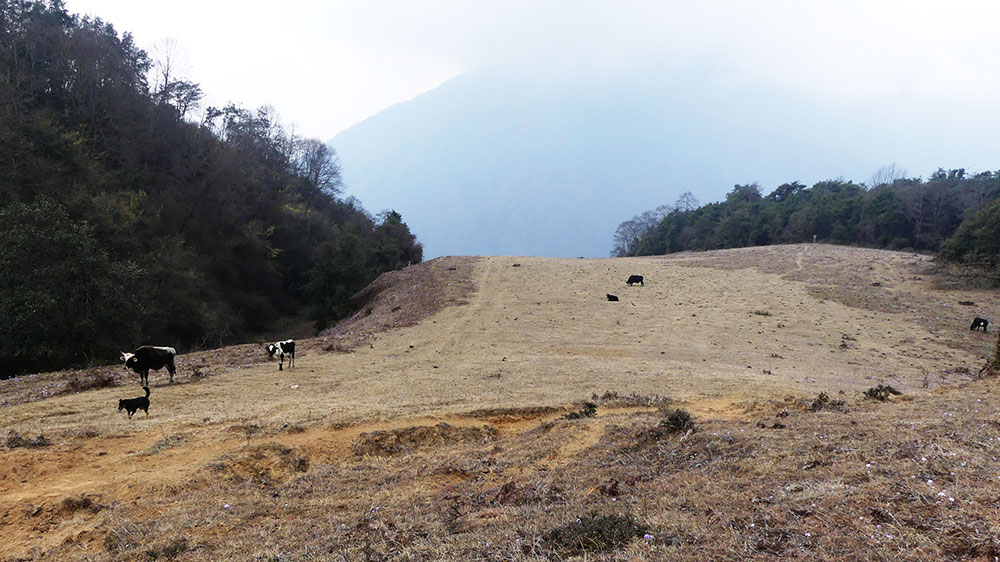YK Poudel
Palden Lhendup, 47-year-old farmer from Semji, Nubi Gewog in Trongsa, has 16 cattle. He lost three to tiger attacks last year.
“If people really feel tigers are important, cage them all. We can then live without fear,” he says, with utter frustration.
Trongsa, a dzongkhag with one of the highest human-wildlife conflict (HWC) cases, has noted about 580 livestock depredations by tiger between 2020 and 2024, of which 360 cases were recorded from Nubi Gewog alone.
Farmers like Palden who depend on growing crops and raising livestock as a means of survival have been facing this particular challenge.
Semji and Jongthang are the two villages where HWC are among the serious problems facing the farmers.
Palden Lhendup has attended several meetings where tiger conservation has been the focus of the talks.
“Yet, it is crucial that Bhutan, a country known for Gross National Happiness, balance between animal conservation along with the happiness of the farming communities,” he said. “Thus far, conservation policies prefer animals over human beings. Should humans always lose this battle?”
Over the years, however, the number of HWC has reduced with intervention from the government and other agencies with the introduction of electric fencing project.
Dorji Gyeltshen, another farmer, looks at the problem differently. “With the increasing wildlife depredation, the gewog has been a national highlight, with government support over the years.”
Dorji Gyeltshen owns 20 cattle. He lost about eight cattle to tigers in the last five years.
“Personally, living with tigers has given advantage to the farmers. The gewog got electric-fencing support,” Dorji Gyeltshen said. “Tiger as an apex predator has ecological significance, for a healthy eco-system.”
The electric fencing, Dorji Gyeltshen said, has helped the farmers in several ways. “There are two pasturelands developed in Nubi Gewog. After the electric fencing project, the number of human-wildlife conflicts in Nubi has reduced drastically.”
Jigme Tshering, a forest official from Trongsa Forest Range Office under Divisional Forest Office, Bumthang said that highland grasses were planted in the pasture, water-holes created, and various approaches taken to support the farmers.
“Within a year of electric fencing, the presence of not only tigers but also other wild animals decreased,” he said.
The Gewog Tiger Conservation Tshogpa scheme has compensated 71 farmers with some amount for the loss, according to Jigme Tshering. “The procedure is done through a mobile application—details of the loss are uploaded for record and compensation process.”
Nubi has developed two pasture areas; one in Semji which is 45-acres in size, and the other in Jongthang — ‘Yalaypang community-based pasture development’ which is a 55-acres pasture land for the farming communities.
Sonam Dorji, 60-year-old farmer from Jongthang, said that the development of pasture has helped the farmers dedicate more time in the farm lands.
“The cattle fear less now. Additionally, with enough grazing land, the production of milk and reproduction is more,” he said.
The farmers say that the main challenge is pastureland management.
“We just have one pastureland where all cattle—about 115 cattle from 23 households graze. After the green grasses are gone within a week or two, the situation deteriorates,” a farmer said.
This pastureland, the farmer said, has the potential to be linked to another one nearby. “Doing so with creation of plots inside where the regeneration of grass can be fostered, perhaps is the best way.”
One of the farmers from Semji noted that the pastureland development has not helped all farmers equally.
“Of 20 households here, only 11 of them reap the benefits of the arrangement within pastureland. Trying to be in the group in such an arrangement has not been successful in the last one year due to legal issues. All farmers must be equally included,” the farmer said.
According to sources, there is an investment of over US Dollar 1.32 million between 2019 and 2024 for Trongsa and Trashigang, supported by UNEP’s Vanishing Treasures Programme, Department of Forest and Park Services, Global Environment Facility and the Department of Livestock.
The International Union for the Conservation of Nature (IUCN) has listed tiger species as endangered with about 3,500 globally—of which 131 are in Bhutan.
Bhutan has an extensive network of protected areas and corridors—52 percent of the country is under protected area.
The killing of a tiger is an offence of fourth degree felony under Bhutan’s Penal Code. An offender is liable for a fine of Nu 1 million under the Forest and Nature Conservation Rules and Regulations of Bhutan 2017.
This news story is from the field notes of our reporter who observed the villages facing human-wildlife conflicts in Trongsa with UNEP’s Vanishing Treasures Programme.


